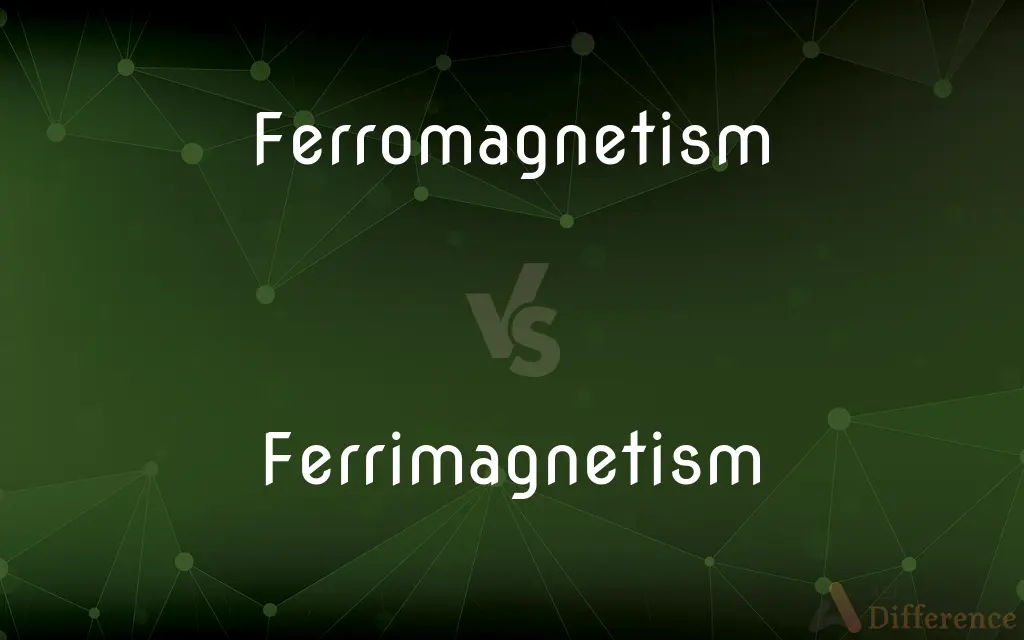Ferromagnetism vs. Ferrimagnetism — What's the Difference?
By Fiza Rafique & Maham Liaqat — Updated on March 16, 2024
Ferromagnetism involves uniform magnetic alignment of atoms resulting in strong magnetism, while ferrimagnetism is characterized by unequal opposite magnetic moments that partially cancel, offering weaker magnetism.

Difference Between Ferromagnetism and Ferrimagnetism
Table of Contents
ADVERTISEMENT
Key Differences
Ferromagnetism is a phenomenon where atoms in a material align their magnetic moments in the same direction due to exchange coupling, leading to strong permanent magnetism. This effect is observed in metals like iron, cobalt, and nickel, making them capable of being permanent magnets. Whereas, ferrimagnetism occurs in materials where magnetic moments of atoms align in opposite directions in unequal magnitudes, causing a partial cancellation yet resulting in net magnetism. Ferrites, a class of ceramic compounds, are common ferrimagnetic materials.
In ferromagnetic materials, the same-direction alignment of magnetic moments results from the exchange interaction among neighboring atoms, which is strong enough to overcome thermal agitation at temperatures below the Curie point. On the other hand, ferrimagnetic materials exhibit a more complex internal magnetic structure due to the presence of different types of ions with magnetic moments that are not completely aligned, leading to a weaker net magnetism.
The key property of ferromagnetic materials is their ability to retain a significant amount of magnetization even after an external magnetic field is removed, demonstrating strong permanent magnetism. Ferrimagnetic materials also retain magnetization but to a lesser extent due to the partial cancellation of magnetic moments.
Temperature plays a crucial role in both ferromagnetism and ferrimagnetism. Ferromagnetic materials lose their magnetism and become paramagnetic above the Curie temperature, where thermal energy disrupts the uniform alignment of magnetic moments. Similarly, ferrimagnetic materials transition to a paramagnetic state at the Curie temperature but due to the disruption of the complex alignment of their magnetic moments.
Applications of ferromagnetic materials include hard drives, motors, and generators, where strong, permanent magnetism is advantageous. Ferrimagnetic materials are used in applications like magnetic recording media, transformers, and microwave devices, where specific magnetic properties, such as weaker magnetism and electrical resistance, are beneficial.
ADVERTISEMENT
Comparison Chart
Magnetic Moment Alignment
Uniform in the same direction.
Opposite directions in unequal magnitudes.
Material Examples
Iron, cobalt, nickel.
Ferrites, garnets.
Magnetism Strength
Strong permanent magnetism.
Weaker net magnetism.
Temperature Effect
Becomes paramagnetic above Curie point.
Also becomes paramagnetic above Curie point.
Applications
Hard drives, motors, generators.
Magnetic recording media, transformers.
Compare with Definitions
Ferromagnetism
Phenomenon where magnetic moments align uniformly in the same direction.
Iron filings aligning along a magnet's field lines exhibit ferromagnetism.
Ferrimagnetism
Leads to weaker net magnetism than ferromagnetism.
Ferrite cores in transformers exploit ferrimagnetism for efficient energy transfer.
Ferromagnetism
Observed in metals like iron, cobalt, and nickel.
Cobalt's ferromagnetic properties make it valuable in alloys for permanent magnets.
Ferrimagnetism
Magnetic moments align in opposite directions with unequal strengths.
Magnetite exhibits ferrimagnetism, crucial in ancient navigation.
Ferromagnetism
Used in creating permanent magnets.
Ferromagnetic materials are essential in the manufacturing of generators and electric motors.
Ferrimagnetism
Common in ceramic compounds like ferrites.
Ferrites are used in microwave devices due to their ferrimagnetic properties.
Ferromagnetism
Characterized by a high Curie temperature.
Nickel has a Curie temperature of 358°C, above which it loses ferromagnetism.
Ferrimagnetism
Has a distinct Curie temperature for transition.
Magnetite becomes paramagnetic above 585°C, its Curie temperature.
Ferromagnetism
Results in strong permanent magnetism.
Neodymium magnets, used in hard drives, are based on ferromagnetic principles.
Ferrimagnetism
Utilized in magnetic storage and transformers.
Ferrimagnetic materials are found in magnetic tapes used for data storage.
Ferromagnetism
Ferromagnetism is the basic mechanism by which certain materials (such as iron) form permanent magnets, or are attracted to magnets. In physics, several different types of magnetism are distinguished.
Ferrimagnetism
A ferrimagnetic material is material that has populations of atoms with opposing magnetic moments, as in antiferromagnetism. For ferrimagnetic materials these moments are unequal in magnitude so a spontaneous magnetization remains.
Ferromagnetism
Of or characteristic of substances such as iron, nickel, or cobalt and various alloys that exhibit extremely high magnetic permeability, a characteristic saturation point, and magnetic hysteresis.
Ferrimagnetism
(physics) a form of antiferromagnetism in which some magnetization remains below a critical temperature (the Neel temperature)
Ferromagnetism
(physics) The phenomenon whereby certain substances can become permanent magnets when subjected to a magnetic field.
Ferrimagnetism
A phenomenon in ferrites where there can be incomplete cancellation of antiferromagnetic arranged spins giving a net magnetic moment
Ferromagnetism
Phenomenon exhibited by materials like iron (nickel or cobalt) that become magnetized in a magnetic field and retain their magnetism when the field is removed
Common Curiosities
Can ferrimagnetic materials become permanent magnets?
Yes, ferrimagnetic materials can become permanent magnets but typically with weaker magnetism compared to ferromagnetic materials.
What distinguishes ferromagnetism from ferrimagnetism?
The main distinction lies in the alignment of magnetic moments; ferromagnetism involves a uniform direction, whereas ferrimagnetism involves opposite directions with unequal magnitudes.
What happens to ferromagnetic materials above the Curie temperature?
They lose their magnetism and become paramagnetic, as thermal agitation disrupts the uniform magnetic alignment.
What role does temperature play in ferrimagnetism?
Temperature affects the alignment of magnetic moments; above the Curie temperature, ferrimagnetic materials become paramagnetic.
Can the magnetism of ferrimagnetic materials be increased?
The magnetism can be optimized by manipulating the material's composition and structure, but it remains inherently weaker than that of ferromagnetic materials.
What is exchange coupling in ferromagnetism?
Exchange coupling is the quantum mechanical phenomenon that causes electrons in atoms to align their spins in the same direction, leading to uniform magnetism.
Can the properties of ferrimagnetic materials be changed?
Yes, through doping or altering the manufacturing process, the magnetic and electrical properties of ferrimagnetic materials can be tailored for specific applications.
Are all metals ferromagnetic?
No, only a few metals like iron, cobalt, and nickel exhibit ferromagnetism, while most others do not.
Why might a company choose ferrimagnetic materials over ferromagnetic for certain applications?
For applications requiring specific magnetic properties, like certain frequencies of electromagnetic wave absorption or electrical resistance, ferrimagnetic materials may be more suitable.
What makes a material ferromagnetic or ferrimagnetic?
The electronic structure and the arrangement of atoms within the material determine whether it exhibits ferromagnetism or ferrimagnetism.
Why are ferrites used in electronic devices?
Due to their ferrimagnetic properties, such as electrical resistance and specific magnetic characteristics, making them suitable for reducing electromagnetic interference.
How does the magnetic strength of ferromagnetic and ferrimagnetic materials compare?
Ferromagnetic materials exhibit stronger magnetism due to the uniform alignment of magnetic moments, whereas ferrimagnetic materials have weaker net magnetism due to partial cancellation.
What is the Curie temperature?
It's the temperature at which ferromagnetic or ferrimagnetic materials lose their magnetic properties and become paramagnetic.
How are ferromagnetic materials used in data storage?
They are used in hard drives and magnetic tapes, where their strong permanent magnetism allows for the storage and retrieval of data.
Share Your Discovery

Previous Comparison
Suburbs vs. Outskirts
Next Comparison
Debian vs. ArchAuthor Spotlight
Written by
Fiza RafiqueFiza Rafique is a skilled content writer at AskDifference.com, where she meticulously refines and enhances written pieces. Drawing from her vast editorial expertise, Fiza ensures clarity, accuracy, and precision in every article. Passionate about language, she continually seeks to elevate the quality of content for readers worldwide.
Co-written by
Maham Liaqat













































